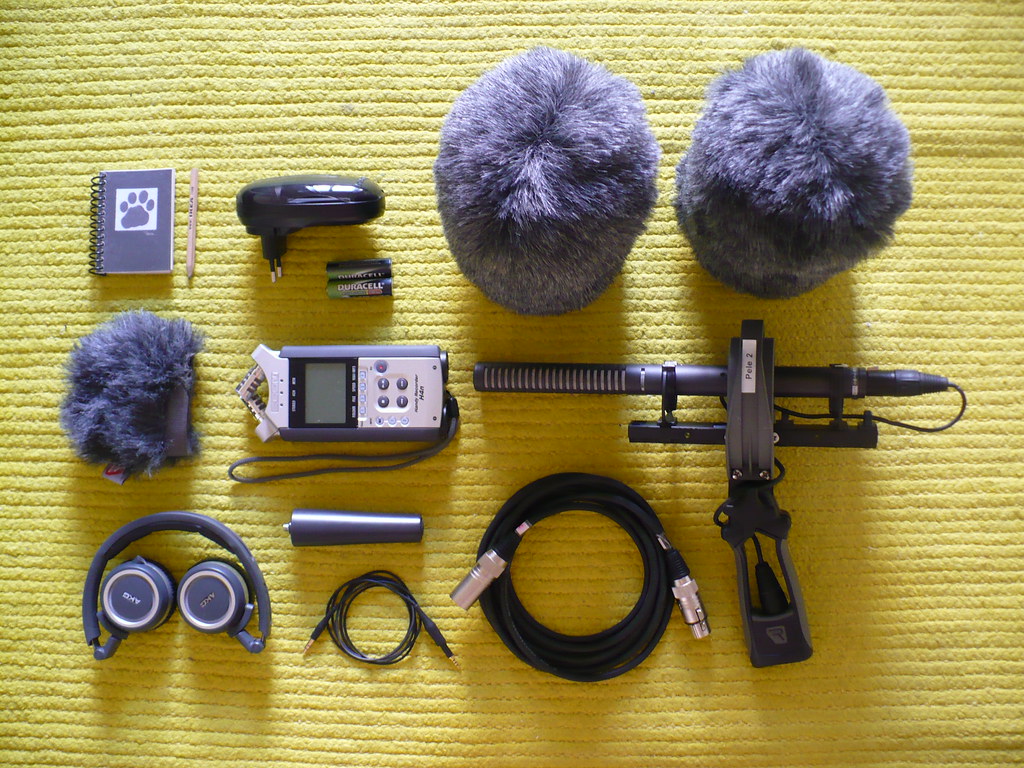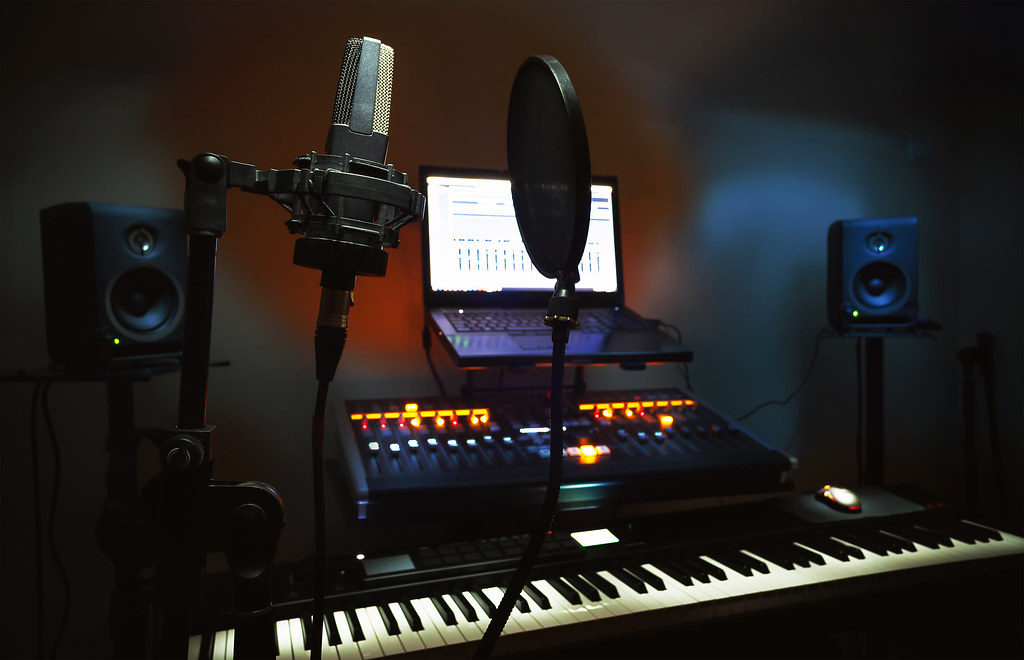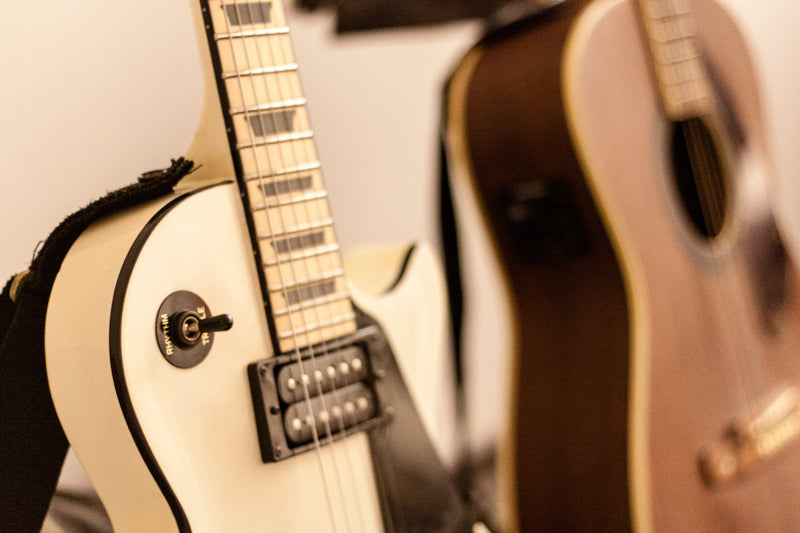Music production hardware is an essential component of any home recording studio. It includes a wide range of devices, such as audio interfaces, MIDI controllers, synthesizers, drum machines, and studio monitors, that are used to create and edit music. In this comprehensive guide, we will explore the different types of music production hardware, how to choose the right hardware for your needs, and provide tips and best practices for recording and editing music using hardware. Whether you’re a beginner or an experienced musician, this guide will help you optimize your home recording studio setup and take your music production to the next level.
Table of Contents

Types of Music Production Hardware
Music production hardware is an essential component of any home recording studio. It includes a wide range of devices that can be used to create, record, and edit music. Here are some of the most common types of music production hardware:
Audio Interfaces
An audio interface is a device that connects your computer to other audio equipment, such as microphones, instruments, and speakers. It converts analog signals into digital signals that can be processed by your computer. Audio interfaces come in different sizes and with different features, such as the number of inputs and outputs, preamps, and built-in effects. Some popular audio interfaces include the Focusrite Scarlett 2i2, the Universal Audio Apollo Twin, and the PreSonus Studio 24c.
MIDI Controllers
A MIDI controller is a device that allows you to control virtual instruments and other software using MIDI signals. It typically includes keys, pads, knobs, and faders that can be assigned to different parameters in your software. MIDI controllers come in different sizes and with different features, such as the number of keys and pads, aftertouch, and velocity sensitivity. Some popular MIDI controllers include the Akai MPK Mini, the Novation Launchkey, and the Arturia KeyLab.
Synthesizers
A synthesizer is a device that generates sound using electronic circuits or digital algorithms. It can be used to create a wide range of sounds, from simple tones to complex textures and effects. Synthesizers come in different types, such as analog, digital, and hybrid, and with different features, such as oscillators, filters, envelopes, and LFOs. Some popular synthesizers include the Moog Subsequent 37, the Roland JD-Xi, and the Korg Minilogue.
Drum Machines
A drum machine is a device that generates drum sounds using electronic circuits or digital samples. It can be used to create drum patterns and loops, and to control other devices using MIDI signals. Drum machines come in different types, such as analog, digital, and hybrid, and with different features, such as sequencers, effects, and sampling capabilities. Some popular drum machines include the Elektron Analog Rytm MKII, the Roland TR-8S, and the Arturia DrumBrute.
Studio Monitors
Studio monitors are speakers that are designed for accurate and transparent sound reproduction. They are essential for mixing and mastering music, as they allow you to hear the details and nuances of your recordings. Studio monitors come in different sizes and with different features, such as frequency response, power output, and connectivity options. Some popular studio monitors include the KRK Rokit 5, the Yamaha HS5, and the JBL 305P MkII.
Other Hardware Devices
There are many other hardware devices that can be used in music production, such as effects processors, compressors, equalizers, and amplifiers. These devices can be used to shape and enhance the sound of your recordings, and to add character and depth to your mixes. Some popular hardware devices include the Universal Audio LA-2A compressor, the Empirical Labs Distressor, and the Eventide H9 effects processor.
As a music producer, I have found that using a combination of hardware and software can lead to more creative and unique results. Experimenting with different types of music production hardware can help you discover new sounds and techniques that can take your music to the next level.
Choosing the Right Music Production Hardware
Choosing the right music production hardware can be overwhelming, especially if you are new to home recording. However, with the right information, you can make an informed decision. Here are some factors to consider when choosing music production hardware:
Budget
Setting a budget is crucial when choosing music production hardware. The cost of music production hardware can range from a few hundred dollars to several thousand dollars. It is important to set a budget that is realistic for your needs and to stick to it. Keep in mind that you may need to invest in additional equipment, such as microphones, cables, and stands, which can add to the overall cost.
Skill Level
Different types of music production hardware require different levels of skill and experience. If you are new to home recording, it may be best to start with a simple setup, such as an audio interface and a MIDI controller, and to gradually add more hardware as you gain experience. On the other hand, if you are an experienced producer, you may want to invest in more advanced hardware to achieve the sound you desire.
Specific Needs
Consider your specific needs when choosing music production hardware. For example, if you are a singer-songwriter, you may need a high-quality microphone and a simple audio interface. If you are a beatmaker, you may need a drum machine and a MIDI controller with pads and knobs. It is important to choose hardware that meets your specific needs and helps you achieve your desired sound.
Compatibility
When choosing music production hardware, it is important to ensure that it is compatible with your existing equipment and software. For example, if you are using a Mac computer, you may need to choose hardware that is compatible with macOS. Similarly, if you are using a specific digital audio workstation (DAW), you may need to choose hardware that is compatible with that DAW.
Brand Reputation
Consider the reputation of the brand when choosing music production hardware. Look for brands that are known for producing high-quality hardware that is reliable and durable. Reading reviews and asking for recommendations from other producers can help you make an informed decision.
By considering these factors, you can choose the right music production hardware for your needs and budget.

Setting Up Your Home Recording Studio
Setting up a home recording studio can be a challenging task, but it is essential for achieving high-quality recordings. Here are some basics to consider when setting up your home recording studio:
Necessary Equipment
To get started, you will need the following equipment:
- *Computer*: A computer with enough processing power and memory to run your DAW software and other music production applications.
- *DAW Software*: Choose a DAW software that is compatible with your computer and that meets your specific needs. There are many DAW software options available, such as Ableton Live, Logic Pro X, and Pro Tools.
- *Audio Interface*: An audio interface is a device that connects your computer to your other music production hardware, such as microphones, instruments, and speakers. It converts analog signals to digital signals and vice versa, allowing you to record and playback audio.
- *Microphone*: You will need at least one microphone to record audio. There are many types of microphones available, such as condenser, dynamic, and ribbon microphones. Choose a microphone that is suitable for your recording needs.
You may also need additional equipment, such as headphones, monitors, and cables. Consider your specific needs and budget when deciding on additional equipment.
Studio Setup
Optimize your studio setup for music production by following these tips:
- *Room*: Choose a quiet and acoustically treated room for your studio. Avoid rooms with hard surfaces, such as concrete walls and floors, as they can cause unwanted reflections and echoes. Consider using acoustic panels, bass traps, and diffusers to improve the acoustics of your room.
- *Equipment Positioning*: Position your equipment in an ergonomic and functional way. Place your computer, audio interface, and other hardware within easy reach and in a way that allows you to work comfortably for long periods of time.
- *Lighting and Ventilation*: Use proper lighting and ventilation in your studio. Avoid harsh lighting that can cause eye strain and fatigue. Ensure that your studio is well-ventilated to prevent overheating and to maintain a comfortable working environment.
Conclusion
By following these tips, you can set up a home recording studio that is optimized for music production. Remember to consider your specific needs and budget when choosing equipment and setting up your studio.

Recording and Editing Music with Hardware
Recording and editing music with hardware can be a rewarding and creative process. Here are some tips and best practices for using different types of hardware to achieve specific sounds and effects:
Audio Interfaces
When choosing an audio interface, it is important to select one with high-quality preamps and converters to ensure clean and accurate recordings. Use the gain control to adjust the input level of your microphone or instrument, and use the headphone output to monitor your recordings. Additionally, consider the number of inputs and outputs you need for your recording setup, as well as the type of connectivity options available.
MIDI Controllers
MIDI controllers are a versatile tool for controlling virtual instruments and effects in your digital audio workstation (DAW). Assign different parameters in your software to the keys, pads, knobs, and faders on your MIDI controller to control various aspects of your music production. Use the velocity sensitivity and aftertouch to add expression and dynamics to your performances, and experiment with different playing techniques to achieve unique sounds.
Synthesizers
Synthesizers are a powerful tool for creating unique sounds and textures in your music production. Experiment with different types of synthesis, such as subtractive, additive, and FM synthesis, to create a wide range of sounds. Use the filters, envelopes, and LFOs to shape and modulate your sounds, and consider incorporating external effects pedals or processors to further enhance your sound.
Drum Machines
Drum machines are a popular tool for creating drum patterns and loops in electronic music production. Use the sequencer and the built-in sounds or samples to create your beats, and experiment with different rhythms and patterns to achieve the desired groove. Use the effects and the sampling capabilities to add variation and interest to your beats, and consider layering different drum sounds to create a more complex and dynamic sound.

Reviews and Recommendations
If you’re looking for the best music production hardware for your home recording studio, here are some user reviews and recommendations for different types of music production hardware:
Audio Interfaces
Audio interfaces are essential for recording and producing music. Here are some of the best audio interfaces on the market:
- Focusrite Scarlett 2i2: This is a popular and affordable audio interface with two inputs and two outputs, high-quality preamps, and low-latency performance. It’s perfect for home recording studios and is compatible with most DAWs.
- Universal Audio Apollo Twin: This is a high-end audio interface with two inputs and four outputs, high-quality preamps and converters, and built-in DSP processing for running UAD plugins. It’s perfect for professional studios and offers exceptional sound quality.
MIDI Controllers
MIDI controllers are used to control virtual instruments and software synthesizers. Here are some of the best MIDI controllers on the market:
- Novation Launchkey: This is a versatile and affordable MIDI controller with keys, pads, knobs, and faders, and integration with Ableton Live. It’s perfect for electronic music producers and live performers.
- Native Instruments Komplete Kontrol: This is a high-end MIDI controller with keys, pads, and knobs, and integration with Native Instruments software. It’s perfect for professional producers and composers.
Synthesizers
Synthesizers are used to create electronic sounds and are essential for electronic music production. Here are some of the best synthesizers on the market:
- Korg Minilogue: This is a popular and affordable analog synthesizer with four voices, a built-in sequencer, and a wide range of sounds. It’s perfect for beginners and professionals alike.
- Moog Subsequent 37: This is a high-end analog synthesizer with two voices, a built-in sequencer, and a classic Moog sound. It’s perfect for professional producers and sound designers.
Drum Machines
Drum machines are used to create electronic drum sounds and are essential for electronic music production. Here are some of the best drum machines on the market:
- Roland TR-8S: This is a versatile and modern drum machine with a wide range of sounds, sampling capabilities, and integration with other devices. It’s perfect for electronic music producers and live performers.
- Elektron Analog Rytm MKII: This is a high-end drum machine with analog and digital sounds, sampling capabilities, and a powerful sequencer. It’s perfect for professional producers and sound designers.
These are just a few examples of the best music production hardware on the market. When choosing the right hardware for your home recording studio, it’s important to consider your budget, skill level, and specific needs.

Latest Trends and Advancements
The music production hardware industry is constantly evolving, with new trends and advancements emerging all the time. Here are some recent developments to keep an eye on:
Virtual Instruments
Virtual instruments are software-based instruments that can be used in a Digital Audio Workstation (DAW) software. They include virtual synthesizers, drum machines, and other types of instruments. Virtual instruments are becoming increasingly popular due to their affordability, versatility, and ease of use. They are also more accessible to musicians who may not have the budget or space for physical instruments. Some popular virtual instrument plugins include Native Instruments’ Kontakt, Spectrasonics’ Omnisphere, and Arturia’s V Collection.
Modular Synthesizers
Modular synthesizers are hardware-based synthesizers that consist of individual modules that can be connected and configured in different ways. Modular synthesizers offer a high degree of flexibility and customization, but they can be expensive and require a steep learning curve. However, they are becoming more popular due to their unique sound and the ability to create complex and intricate sounds that are difficult to achieve with other types of synthesizers. Some popular modular synthesizer brands include Make Noise, Mutable Instruments, and Intellijel.
Wireless Connectivity
Some music production hardware devices now offer wireless connectivity, allowing you to control them using your smartphone or tablet. This can be useful for live performances and for controlling devices from a distance. For example, the Akai Professional MPC Live II and the Novation Launchpad Pro MK3 both offer wireless connectivity. This feature allows musicians to control their devices without being tethered to a computer or other hardware. It also allows for more flexibility in live performances, as musicians can move around the stage while still controlling their devices.

Troubleshooting Common Issues
If you’re experiencing issues with your music production hardware, don’t worry – you’re not alone. Here are some common issues that may arise when using music production hardware and how to troubleshoot them:
Latency
Latency is the delay between the input signal and the output signal. It can be caused by a slow computer, a high buffer size, or a slow audio interface. To reduce latency, try the following:
- Lower the buffer size: A smaller buffer size will reduce the amount of time it takes for your computer to process the audio signal, which can help reduce latency.
- Close unnecessary applications: Closing any unnecessary applications running on your computer can free up resources and reduce latency.
- Use a faster audio interface: If your audio interface is outdated or slow, consider upgrading to a faster one to reduce latency.
Noise
Noise can be caused by interference from other devices, poor grounding, or faulty cables. To reduce noise, try the following:
- Use shielded cables: Shielded cables can help reduce interference from other devices and reduce noise.
- Separate your devices: Keep your devices separated from each other to reduce interference and noise.
- Use a power conditioner: A power conditioner can help filter out noise and interference from your power source.
Driver Issues
Driver issues can cause your hardware to malfunction or not work at all. To fix driver issues, try the following:
- Update your drivers: Check the manufacturer’s website for the latest drivers for your hardware and install them.
- Reinstall your software: If updating your drivers doesn’t work, try reinstalling your software.
- Contact customer support: If you’re still having issues, contact the manufacturer’s customer support for further assistance.
Conclusion
In conclusion, music production hardware is a crucial element in creating high-quality music in a home recording studio. By selecting the appropriate hardware, setting up your studio correctly, and following best practices for recording and editing, you can unleash your creativity and produce professional-sounding tracks.
It is essential to keep up with the latest trends and advancements in the industry to stay ahead of the game. Don’t be afraid to experiment and try new things to find your unique sound.
We hope this comprehensive guide has provided you with valuable insights and recommendations for selecting and using music production hardware. Check out our other content for more tips and tricks on home recording studio equipment.
Start creating your music today and let your creativity soar!
As an experienced music producer and home recording enthusiast for over a decade, I have a deep understanding of the challenges faced by musicians when it comes to finding the best budget PC for music production. Throughout my career, I have worked with various software and hardware setups, experimenting with different PC configurations to optimize my workflow and achieve professional-quality results. My extensive knowledge in this field has been further enhanced by my academic background in computer science, where I conducted research on the impact of processor speed on audio rendering and the benefits of SSD storage in reducing latency during music production. Additionally, I have closely followed industry trends and consulted with experts in the field to ensure that the recommendations provided in this guide are based on the latest advancements and reliable data. By combining my practical experience, academic insights, and research-backed information, I aim to provide musicians and aspiring producers with a comprehensive guide that will empower them to make informed decisions and elevate their music production endeavors.

